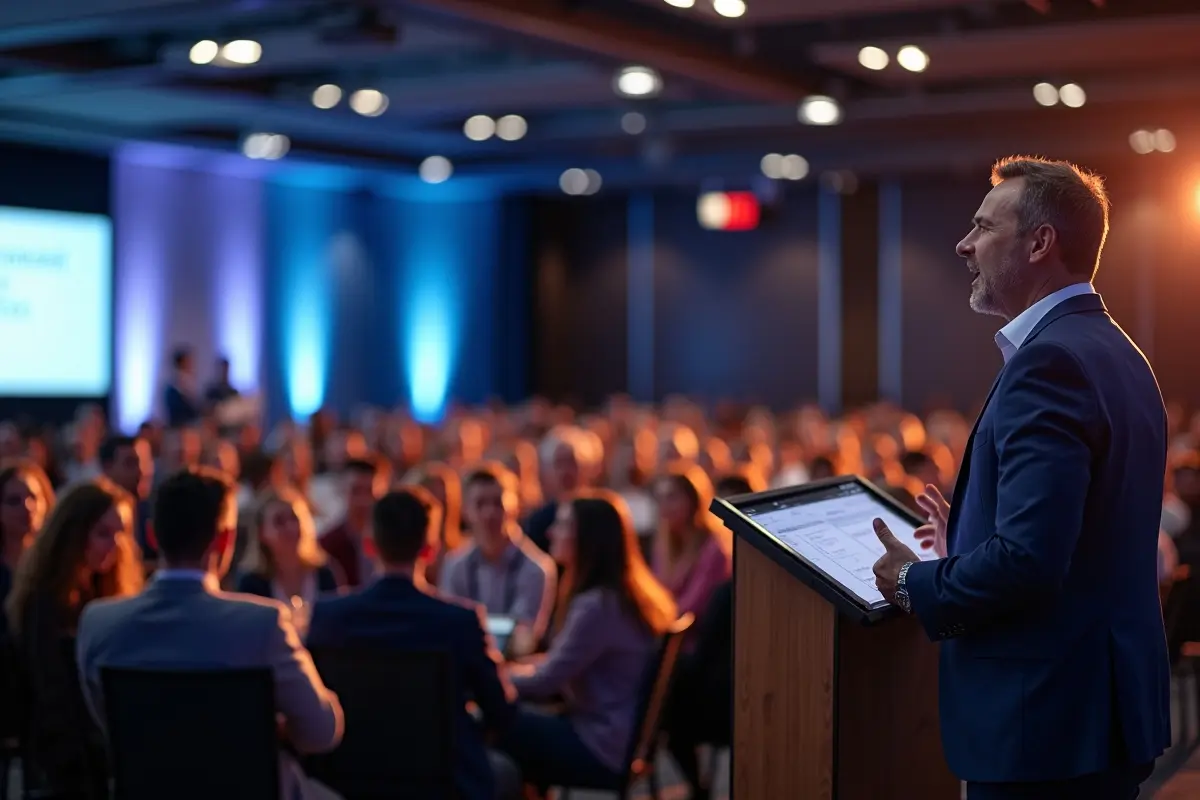The opening keynote isn’t just another session on the agenda – it’s the moment that defines what attendees can expect from the entire conference. That first hour shapes perceptions, establishes energy levels, and creates a framework through which everything else gets filtered.
A strong keynote launch transforms a room full of strangers into an engaged audience ready to participate. A weak one creates an uphill battle for every session that follows.
Creating the First Impression That Lasts
Conference attendees walk into that opening session carrying their own expectations, skepticism, and concerns about whether this event will be worth their time. The keynote speaker has maybe ten minutes to either validate their decision to attend or confirm their suspicions that they should have stayed at the office.
Energy matters immediately. A keynote that starts with flat delivery, low enthusiasm, or apologetic tone tells attendees this conference might not deliver what was promised. Conversely, a speaker who commands the room from the first sentence, demonstrates genuine passion for the topic, and creates immediate connection signals that the organizers put real thought into the experience.
The content approach in those opening minutes sets expectations for depth and relevance throughout the conference. If the keynote stays surface-level and generic when the audience came for tactical insights, they’ll question whether the breakout sessions will offer any real value. If it dives deep into concepts that go over most heads, attendees worry they’re in the wrong place entirely.
Audience connection happens fast or it doesn’t happen at all. Keynote speakers who acknowledge the specific challenges their audience faces, reference current industry conditions, or demonstrate understanding of why people are in that room create instant credibility. Those who launch into generic motivational content without context might as well be speaking to a different group entirely.
Establishing the Conference Theme and Framework
A well-chosen keynote doesn’t just present interesting ideas – it provides the conceptual framework that ties the entire conference together. This becomes the lens through which attendees process every subsequent session, conversation, and networking interaction.
Theme reinforcement works when the keynote speaker embodies what the conference claims to be about. A conference focused on innovation that features a keynote stuck in traditional thinking creates cognitive dissonance. One about authentic leadership that showcases a speaker clearly performing a persona undermines its own message before the first breakout session begins.
The best keynotes introduce concepts, terminology, or frameworks that resurface throughout the event. When breakout speakers reference ideas from the opening keynote, when attendees use new vocabulary in hallway conversations, when the closing remarks callback to morning themes – that’s when the conference achieves cohesion instead of feeling like a random collection of sessions.
Organizers selecting motivational keynote speakers need to ensure the message aligns not just with the conference theme but with the overall arc of the event. The keynote should pose questions that later sessions help answer, introduce challenges that workshops help solve, or present visions that subsequent content helps attendees implement.
Building Energy That Carries Through
Conference energy is fragile. It peaks and valleys throughout the event, but the baseline gets established in that opening keynote. Starting high gives room for natural dips while maintaining overall engagement. Starting low means fighting exhaustion and disengagement for the duration.
Inspirational content works when it connects to action. A keynote that just pumps people up with motivational platitudes creates temporary excitement that fades during the first coffee break. One that inspires while also providing frameworks, next steps, or practical applications gives attendees something to carry into the rest of their conference experience.
The emotional tone established by the keynote ripples outward. A speaker who creates moments of reflection, laughter, surprise, or genuine insight gives attendees emotional variety that keeps them present and engaged. Monotone delivery – whether monotone serious or monotone enthusiastic – exhausts audiences mentally even if the content is solid.
Interaction level in the keynote signals what’s expected throughout the conference. If the opening speaker creates moments for audience participation, asks questions (even rhetorical ones that get heads nodding), or acknowledges the people in the room, attendees understand this isn’t a passive listening experience. If the keynote is purely one-way communication, people settle into consumer mode rather than participant mode.
Influencing Attendee Mindset and Openness
The keynote speaker’s credibility directly impacts how attendees approach everything that follows. When the opening speaker demonstrates deep expertise, shares relevant experience, and earns trust, attendees give subsequent speakers the benefit of the doubt. When the keynote falls flat, every following speaker starts from a deficit of skepticism.
Challenging assumptions early creates space for new thinking throughout the event. A keynote that makes people question their current approaches, consider alternative perspectives, or recognize gaps in their knowledge primes them to actually absorb information in later sessions. One that just confirms what everyone already believes might feel comfortable but doesn’t prepare minds for learning.
The balance between comfort and discomfort matters enormously. Too comfortable and people don’t engage with new ideas. Too uncomfortable and they resist and disengage. Strong keynote speakers find that sweet spot where the audience feels challenged but not attacked, stretched but not broken, curious rather than defensive.
Storytelling in the keynote humanizes the conference content. Personal stories, case studies, or narrative examples in the opening session remind attendees that the concepts being discussed apply to real situations with real consequences. This context makes abstract ideas from later sessions easier to grasp and apply.
Setting Professional Standards and Expectations
The keynote speaker’s professionalism becomes the baseline for what’s acceptable throughout the conference. Arriving late, going over time, or delivering disorganized content signals that maybe this event isn’t as buttoned-up as the marketing materials suggested. Tight execution, respect for the schedule, and polished delivery tells attendees the organizers are serious about quality.
Production quality for the keynote sets the bar visually and technically. If the opening presentation features good lighting, clear audio, readable slides, and smooth transitions, attendees expect that level throughout. Technical problems during the keynote create anxiety about whether the rest of the conference will be equally rough.
Content depth in the keynote signals what level of substance to expect from other sessions. Surface-level keynote content makes people wonder if they’ll get any real tactical value from breakouts. Dense, research-backed keynote presentations establish that this conference treats attendees as intelligent professionals who can handle complexity.
The speaker’s respect for the audience shows in a dozen small ways – pronouncing organization names correctly, referencing current industry news, avoiding outdated examples, acknowledging diverse perspectives. These details signal whether speakers did their homework or are just delivering generic content with a few customized slides.
The Ripple Effect on Networking and Engagement
Conference networking gets a massive boost from strong keynote content. When the opening speaker introduces compelling ideas, attendees have immediate conversation starters. The hallway chatter shifts from weather and travel delays to actual discussion of concepts, questions raised, or reactions to what was shared.
Shared experience bonds strangers into a temporary community. Everyone in that room heard the same message, reacted to the same moments, and now has a common reference point. This creates natural connection opportunities that isolated breakout sessions can’t match. The keynote becomes the collective memory that defines “remember at that conference when…”
Social media activity spikes after strong keynotes. Attendees share quotes, insights, photos, and reactions that extend the conference’s reach beyond the physical venue. This organic promotion benefits the current event and builds anticipation for future ones. Weak keynotes generate silence online – people don’t share content that didn’t impact them.
The keynote speaker’s accessibility after their presentation also shapes conference culture. Speakers who stick around for questions, join networking sessions, or engage with attendees in hallways demonstrate that this is a participatory event rather than a performance. Those who deliver their speech and disappear reinforce a hierarchy that can make attendees feel more like consumers than participants.
The Long-Term Impact on Conference Reputation
What people remember about a conference six months later often comes down to that opening keynote. The specific breakout sessions blur together, but the keynote moment that made them laugh, think differently, or see new possibilities stays sharp. That lasting memory determines whether they register for next year or recommend the event to colleagues.
Strong keynotes become conference marketing material. Video clips, quotes, and testimonials from powerful opening sessions convince potential future attendees that this event delivers value. Mediocre keynotes become something organizers try to move past rather than highlight in promotions.
The standard set by each year’s keynote creates pressure and expectation for the next event. Nail it once and the audience expects that quality going forward. Phone it in and people approach the next conference with lowered expectations that become self-fulfilling prophecies when attendance drops or engagement suffers.
Ultimately, the keynote speaker’s role goes far beyond filling an hour on the schedule. They set the energy, establish credibility, frame the content, shape attendee mindset, and create the shared experience that transforms a collection of sessions into a cohesive event worth attending. Getting this critical piece right makes everything else easier. Getting it wrong means fighting an uphill battle no amount of excellent breakout content can fully overcome.




